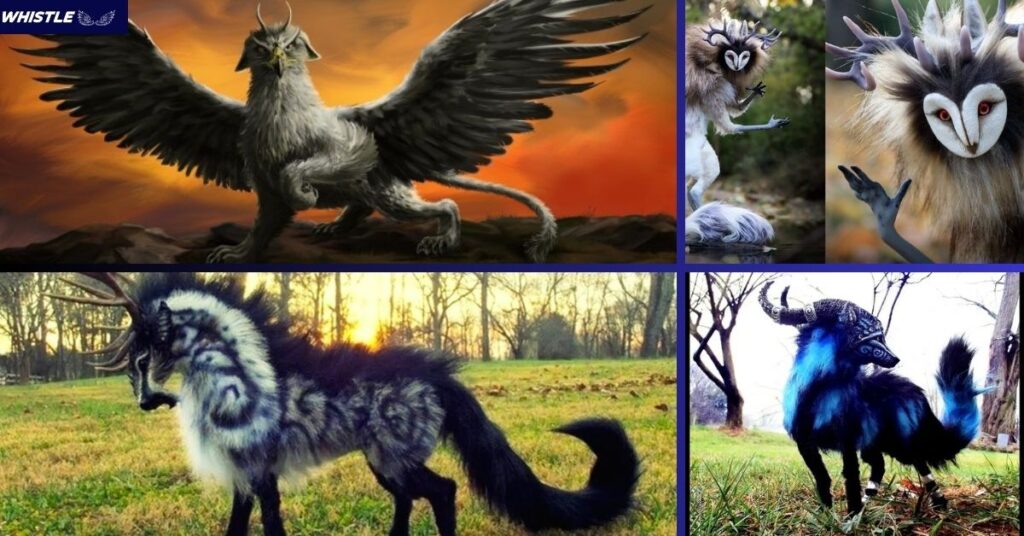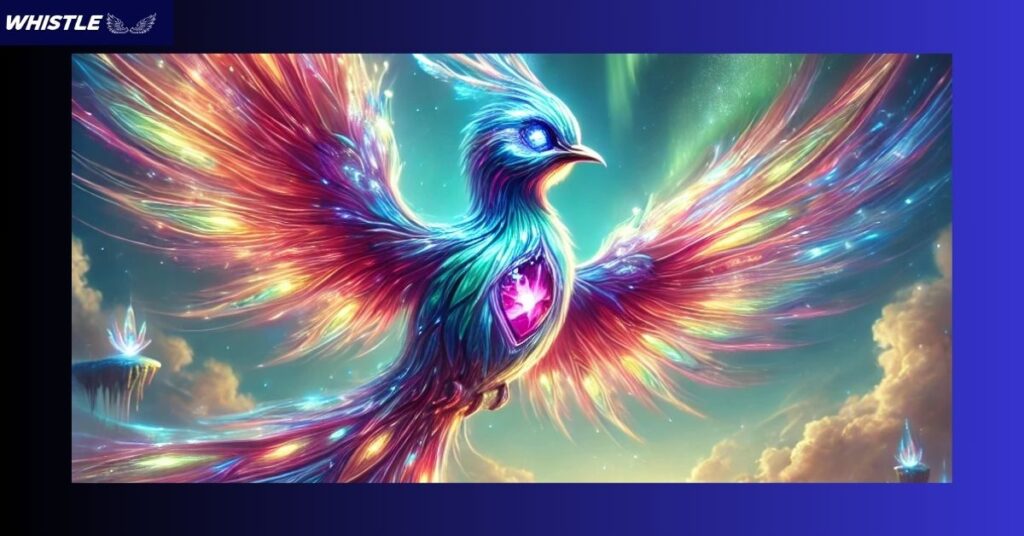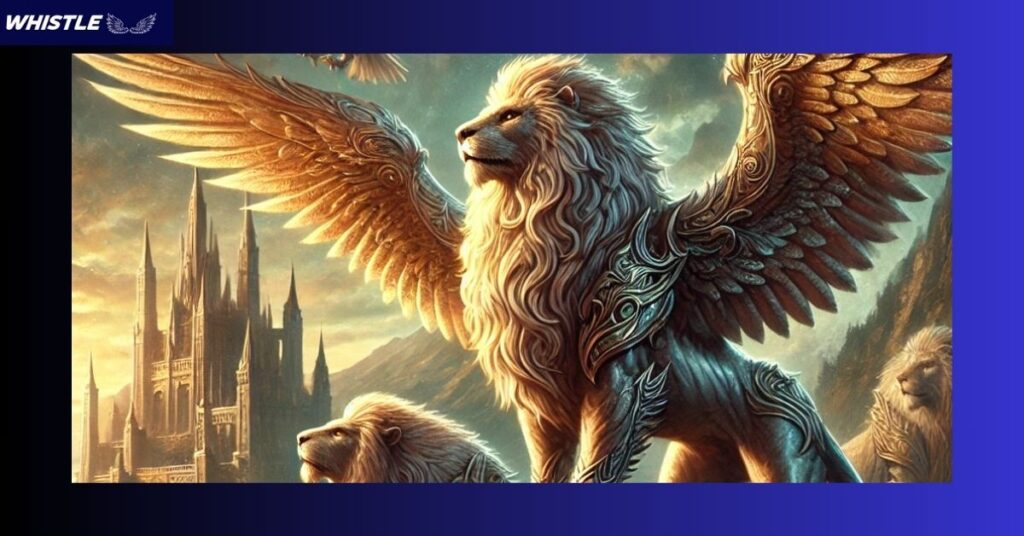For centuries, mythical birds and creatures have captivated the imaginations of people worldwide. These legendary beings often symbolize power, wisdom, destruction or renewal. From the Phoenix that rises from its ashes to the Roc that can lift elephants; mythical creatures reflect both human fears and aspirations.
Throughout history! different civilizations have created stories around these magical beings. Some were considered divine messengers while others were feared as harbingers of doom.
This article explores the most famous mythical birds and creatures, their meanings, origins, and enduring presence in myths.
Key Takeaways:
- Symbolism: Mythical birds (e.g., Phoenix: rebirth, Thunderbird: power, Simurgh: wisdom, Garuda: protection) and creatures (e.g., Griffin: strength, Unicorn: purity) embody human emotions and cultural values.
- Key Birds: Phoenix, Roc, Garuda, Thunderbird, Simurgh, Caladrius, Benu, Firebird, Huma, Alicanto represent renewal, power, and fortune.
- Creatures: Griffin, Unicorn, Dragon, Kraken, Chimera, Pegasus, Mermaid, Centaur, Minotaur, Leviathan.
- Bird Gods: Ra (sun), Garuda (protector), Thoth (wisdom).
- Fantasy Birds: Griffons, Hippogriffs, Stormcrows, Shadow Birds.
- Impact: Inspire art, literature, and storytelling, reflecting humanity’s mystical fascination.
What are Mythical Birds and Their Meanings?
First of all, mythical birds are mythological beings incorporated into the folklore, mythology, and cultural stories of ancient civilizations across the globe. Much more than imaginary creatures, these birds possess deep symbolic significance. They tend to be divine messengers, omens, or symbols of cosmic forces, symbolizing both the hopes and fears of the cultures that produced them.

These supernatural birds, either drawn as simply bird-like or hybrids with human or animal characteristics, have magical powers, enormous strength, or divine affinities. Their histories, maintained in oral lore, religious writings, and contemporary versions, emphasize their long-lasting cultural importance.
Rebirth and Renewal:
The Phoenix is the most powerful symbol of rebirth and renewal, the blazing bird with international fame across Greek, Egyptian, and Chinese mythologies. It burns in fire only to emerge again anew from its own ashes, which symbolize the cycle of life, death, and resurrection. In Egyptian mythology, the Phoenix is inextricably associated with the Benu bird, which is connected with creation and the rebirth of the sun each day.
The Phoenix symbolizes mankind’s aspiration to immortality and tenacity, being a symbol of hope and the power of endurance that appeals to all mankind. Its story is one that resonates with the transformation of human experience, and thus it’s one of the most abiding mythical symbols.
Power and Strength:
In Native American mythology, the Thunderbird represents raw strength and power. Feared by tribes like the Lakota and Ojibwe, it makes thunder with its wings and fires lightning from its eyes, able to control storms and weather. Seen as a guardian spirit, the Thunderbird protects against evil and brings life-giving rain, its immense power both feared and respected.
This bird symbolizes nature’s untamed forces and the strength to overcome chaos, resonating with humanity’s awe of natural phenomena. Its presence in tribal stories underscores the reverence for the environment and the belief in spiritual protectors capable of shaping the world.
Wisdom and Knowledge:
Also, in Persian legend, Simurgh is an old, sage bird and commonly a hybrid peacock-lion-dog-like creature honored with immense wisdom and counsel. It assists heroes in the Shahnameh epic like Prince Zal, imparting healing and insight. Simurgh is the bridge from earthly to heavenly life, interjecting spiritual into material reality with divine understanding.
Its positioning as a mentor demonstrates the human desire for knowledge and spiritual understanding, especially during times of turmoil. The Simurgh’s continued presence in Persian literature speaks to the importance placed on wisdom as a central guide through the trials of life.
Protection and Loyalty:
Furthermore, Garuda, a sacred bird in Hindu and Buddhist mythology, is the vehicle of Lord Vishnu and a powerful protector against evil. Portrayed as a half-man, half-eagle of unmatched speed and power, Garuda represents unwavering commitment and divine protection.
In Hindu scripture such as the Mahabharata, its strength is an asset, and in Southeast Asian societies, it is a national symbol in Indonesia and Thailand, where it signifies protection and power. Garuda represents virtues of duty, dedication, and the protection of righteousness, a loyalty to a greater purpose.
Healing and Purification:
Of equal significance, the Caladrius, a white bird of Roman mythology, is endowed with extraordinary healing abilities. It takes on disease from the afflicted and ascends toward the sun, cleansing the illness and restoring wellness. During medieval Europe, the Caladrius had evolved into a symbol of hope and was most commonly associated with Christian concepts of salvation, even though its inability to gaze upon a patient indicated certain death.
The bird is a symbol of human aspiration for bodily and spiritual cure, as well as purity necessary to defeat illness. Its tale is evidence of the old belief in supernatural action as a means of warding off suffering, a motif found throughout cultures.
Creation and Cosmic Order:
Moreover, in Egyptian mythology, the Benu bird is closely associated with the sun god Ra and the process of creation. Having been thought to have created itself, the Benu contributed to the formation of the world and is linked with the benben stone, an icon of cosmic origins. It symbolizes the passage of time and cyclical renewal of life, frequently being seen in funerary texts as a guide for the soul.
The Benu represents human aspiration for knowledge of the universe and the inception of being, exemplifying cultural value of order and continuity in Egyptian ideology. Its association with the sun serves to reinforce the respect paid to celestial powers as forces behind life.
Fortune and Destiny:
The Huma bird, also present in Persian and Sufi mythology, is an imaginary bird that never descends and is continuously in flight in the air. Legends have it that those who are touched by its shadow are granted immense luck, usually ascending to positions of authority. As a sign from the divine, the Huma signifies spiritual aspiration and divine favor, especially in Sufi poetry, where it is used to symbolize the soul’s quest for enlightenment. Its connection with luck and lofty destiny mirrors mankind’s aspiration for divine intervention and the search for a higher cause. The Huma’s otherworldly quality makes it a potent icon of aspiration and transcendence.
Mystery and Enlightenment:
Similarly, the Firebird, an incandescent Slavic mythical creature, burns with its radiant feathers, promising good fortune but also tribulation to those who pursue it. In Russian folk tales, its feathers are sought after, yet catching the Firebird involves conquering great adversity, representing the price of ambition.
This bird symbolizes mystery, beauty, and the transformative quality of enlightenment, and it symbolizes the human quest for truth and the price one pays to achieve it. The Firebird’s elusive existence increases its appeal as a strong symbol of fate and the blessings of sticking with something through adversity.
Greed and Moral Lessons:
Lastly, in Chilean legend, the Alicanto is a radiant bird that glows with gold and silver colors, leading miners to buried riches. But it takes the greedy astray, and the Alicanto is a warning against greed. Based on Chile’s mining heritage, the Alicanto is a symbol of the double-edged nature of wealth as both a blessing and a curse. It represents good fortune moderated by ethical integrity, emphasizing the repercussions of unbridled greed.
Top 10 Mythical Birds in Mythology – You Must Know!
For centuries, different cultures have told stories about powerful and mysterious birds. These legendary creatures symbolize immortality, wisdom, strength, and divine intervention. Below are ten of the most famous mythical birds and the fascinating tales that surround them.

1. Phoenix: The Bird of Rebirth
The Phoenix stands as one of the most famous mythical birds, appearing in Greek, Egyptian, and Chinese legends. This fiery bird burns itself to ashes and then rises again, symbolizing immortality and renewal. Many cultures associate it with the cycle of life, death, and rebirth.
2. Roc: The Giant Predator of the Skies
The Roc dominates Middle Eastern and Arabian folklore, particularly in One Thousand and One Nights. This massive bird carries off elephants and destroys entire ships with its powerful claws. Sailors feared encountering the Roc because of its enormous size and strength.
3. Garuda: The Divine Protector
Garuda, a divine bird in Hindu and Buddhist mythology, serves as Lord Vishnu’s mount. Depictions show it as a half-man, half-eagle creature with incredible speed and power. Garuda fights against evil forces and protects the righteous, symbolizing strength and divine protection.
4. Thunderbird: The Storm Bringer
The Thunderbird holds a special place in Native American mythology. It flaps its wings to create thunder and shoots lightning from its eyes. Many tribes see the Thunderbird as a guardian spirit that brings rain and shields people from evil.
5. Simurgh: The Wise Healer
The Simurgh, a legendary bird from Persian mythology, guides and heals those in need. Artists depict it as a blend of a peacock, lion, and dog. The Simurgh shares its wisdom with heroes and connects the earth and the heavens.
6. Caladrius: The Bird of Healing
The Caladrius appears in Roman mythology as a pure white bird with healing powers. It absorbs illnesses from sick individuals and flies toward the sun, carrying the disease away. People believed that if the Caladrius refused to look at a sick person, their fate was sealed.
7. Benu: The Egyptian Bird of Creation
The Benu bird plays a key role in Egyptian mythology and connects closely to the sun god Ra. Egyptians believed the Benu created itself and helped shape the world. This bird symbolizes creation, renewal, and the passage of time.
8. Firebird: The Glowing Mystery
The Firebird shines brightly in Slavic folklore, glowing like flames with its radiant feathers. It brings great fortune to those who find it, but capturing it often leads to trials and hardships. The Firebird represents mystery, enlightenment, and destiny.
9. Huma: The Bird of Fortune
The Huma, a mythical bird in Persian and Sufi traditions, never lands on the ground and constantly soars in the sky. Legends claim that those touched by the Huma receive great fortune and rise to positions of power. This bird symbolizes divine favor and high status.
10. Alicanto: The Treasure Guide
The Alicanto, a legendary bird from Chilean folklore, glows with the colors of gold and silver. It guides lucky miners to hidden treasures but leads the greedy to their doom. The Alicanto represents fortune, greed, and the mythical connection between nature and wealth.
Read More About: Green Cheeked Conure – A Complete Guide for Pet Owners!
9 Mythical Creatures List – Legendary Beasts from Folklore and Mythology!
Mythical creatures often accompany these legendary birds, creating a rich tapestry of folklore. Here’s a list of some of the most famous mythical creatures:

| Creature | Origin | Description |
| Griffin | Greek mythology | A lion-eagle hybrid symbolizing strength and vigilance. |
| Unicorn | European folklore | A horse-like creature with a single horn, representing purity and grace. |
| Dragon | Global mythology | A serpentine or reptilian creature often associated with fire and power. |
| Kraken | Norse mythology | A giant sea monster capable of sinking ships. |
| Chimera | Greek mythology | A fire-breathing hybrid of lion, goat, and serpent. |
| Pegasus | Greek mythology | A winged horse symbolizing freedom and inspiration. |
| Mermaid | Global folklore | Half-human, half-fish creatures often associated with the sea. |
| Centaur | Greek mythology | Half-human, half-horse beings symbolizing duality. |
| Minotaur | Greek mythology | A bull-headed humanoid creature residing in the Labyrinth. |
| Leviathan | Biblical and Jewish | A massive sea serpent representing chaos and power. |
Top 3 Bird Gods in Mythology – Divine Avian Beings Across Cultures!
Throughout history! Many civilizations have worshiped bird gods. These divine avian beings often represented the forces of nature and the connection between the heavens and the earth. Below are some of the most significant bird gods from different mythologies.
Ra: The Falcon-Headed Sun God
In Egyptian mythology! Ra stands as the most powerful deity. Depicted with the head of a falcon and a sun disk above his head, Ra symbolizes life, warmth and divine authority. Egyptians believed he traveled across the sky during the day and descended into the underworld at night to battle chaos.
Garuda: The Divine Protector of Vishnu
Garuda is a mighty bird deity in Hindu and Buddhist traditions. It serves as the mount of Lord Vishnu. Hindu texts describe him as a symbol of power, speed and protection. In many Southeast Asian cultures, Garuda remains an important figure.
Thoth: The Ibis-Headed God of Wisdom
Thoth, another Egyptian deity, takes the form of an ibis-headed god associated with writing, knowledge, and the moon. Ancient Egyptians credited Thoth with the invention of hieroglyphics and saw him as the keeper of wisdom. His bird-like form emphasizes the sacred role of birds in understanding the universe and bridging the human and divine worlds.
These bird gods demonstrate the deep reverence that ancient civilizations had for avian creatures.
Learn More About: Male vs Female Cardinals – 5 Key Differences Explained!
4 Fantasy Bird Species – Legendary Birds in Literature and Folklore!
Fantasy stories, mythology and folklore have long featured majestic and mystical bird species. Many of these creatures draw inspiration from ancient myths, making them even more fascinating. These legendary birds often symbolize strength, magic, and destiny in various fantasy worlds.

Griffons: The Majestic Guardians
Griffons, mythical creatures with the body of a lion and the wings and head of an eagle, frequently appear in medieval and fantasy literature. Writers often depict them as noble guardians of treasures and powerful beings of war. In ancient legends, people believed that griffons possessed unmatched strength, making them nearly invincible in battle. Their eagle-like features emphasize intelligence and sharp vision, while their lion bodies represent courage and dominance.
Hippogriffs: The Hybrid of Air and Land
Hippogriffs, magical creatures with the front half of an eagle and the back half of a horse, became popular through medieval tales and modern fantasy stories like Harry Potter. These creatures symbolize the blending of two worlds—speed and flight from the eagle, strength and endurance from the horse. In mythology, only the bravest warriors could tame a hippogriff, making them symbols of honor and adventure.
Stormcrows: The Harbingers of Prophecy
Stormcrows often appear in fantasy stories as omens of change or destruction. These large, dark-feathered birds usually serve as messengers of fate, warning people of impending war, death, or disaster. Many fantasy authors use stormcrows as a symbol of foresight and destiny, making them an important element in storytelling.
Shadow Birds: The Creatures of Darkness
Shadowbirds, mysterious creatures in gothic and dark fantasy literature, lurk in the shadows and represent the unknown. Some legends describe them as spirits trapped between worlds, while others see them as magical birds that absorb light. Their eerie presence often foreshadows major events or hidden secrets within fantasy tales.
Fantasy literature continues to introduce new bird species inspired by mythology. These creatures add depth to storytelling and reflect the timeless fascination with birds as mystical beings.
FAQs:
What is the most mystical bird?
The Phoenix is the most mystical bird. It has the power to rise from its own ashes after death. This legendary creature represents immortality and renewal. Many cultures, including Greek and Egyptian, see the Phoenix as a symbol of eternal life.
What is the legendary mythical bird?
The Thunderbird is a legendary bird in Native American mythology. It controls storms and creates thunder with its wings. Its eyes shoot lightning, showing its immense power. Many tribes believe the Thunderbird protects people and brings rain.
Who is the Greek god of birds?
Aetos Dios is the eagle of Zeus. This divine bird serves as Zeus’ messenger and symbol of power. In Greek myths, Zeus sends the eagle to carry out his will. The eagle represents strength and divine authority.
What is the mythical bird-human creature?
The Harpy is a mythical bird-human creature from Greek mythology. It has the face of a woman and the body of a bird. Harpies act as messengers of the gods and punish wrongdoers. Myths describe them as fast and relentless.
Conclusion:
These legendary beings remain a vital part of our cultural heritage, symbolizing power, wisdom, rebirth and destruction. From the fiery Phoenix to the mighty Thunderbird; these mythical birds continue to inspire art, literature and storytelling.
Each of these creatures has a unique story. Some serve as divine protectors. Others act as omens of fate or mystical beings of wisdom. Their presence in mythology shows that humanity has always looked to the skies for inspiration.
Their stories remind us how myths shape cultures. These legends continue to influence modern storytelling.
Read More:
- Must Read: 50 Types of African Finches – With Features & Photos!
- Must Read: What Eats Birds?
- Must Read: How To Stop Birds From Pooping On Car? 10 Proven Strategies!
